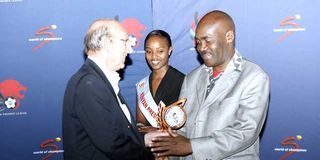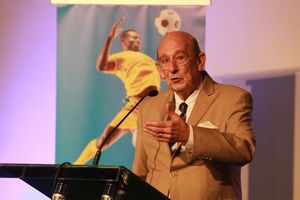
Bob Munro during the Urban Refugees Rights Based and Inclusive tournament at Mathare Youth Sports Association Headquarters along Kangundo Road on April 05, 2023.
For a sports journalist, my personal encounter with the late Bob Munro was fairly recently. As recent as 2021. And it was purely by chance.
At the time, former Nation sports editor, Elias Makori, had commissioned my satirical weekly column. My brief was to get under the skin of anyone who was doing injustice to Kenyan sports.
That was quite some latitude, given the gross maladministration that is legendary of Kenyan sports. Week in, week out, I never ran short of a target to take aim at in the column.
On a few rare occasions, though, the column would dish out bouquets to deserving individuals who were doing something meaningful for sports in the country – the Bob Munros of this world.
One Saturday morning, I was pleasantly surprised to receive an email from Munro with an interesting feedback for my article that weekend.
“I enjoyed your Dandora Love FC riff this morning. So I thought you’d enjoy these MYSA youth team names in 1988. To be a top football player requires mental strength and agility. So one of my favourites is the last one: Mathare Mental FC,” Munro’s brief email read.
Attached to the email was a pdf document titled “1998 Special MYSA Youth Team Names.”
Some of the interesting names in the list included Bash Street Boys FC – a much dreaded side, according to Munro – Lucky Strikers FC, Machuma Sportiff FC and Mashteam FC, a team made up of players from a neigbourhood which was infamous for drug dealings.
That email set off a series of emails and WhatsApp messages that we exchanged for more than two years.
Not a man given to deference, in one of our initial correspondence, Munro chided me – in the politest way – when I made the mistake of calling him “Mr Munro”.

Mathare United chairman Bob Munro (left) presents the 2012 KPL Football Writer of the Year second runners-up trophy to Nation Sports writer John Ashihundu during the Tusker Premier League awards ceremony at Pan Afric Hotel on December 11, 2012.
“I appreciate your polite use of ‘Mr.’ But I usually reserve that title for really old guys. So I rarely use it myself as there are now so few people older than me. For myself, I simply prefer ‘Bob’,” he wrote.
Thereafter, I stuck to calling him Bob.
Though he never said it, I got the impression that with time Munro became one of the biggest fans of my column. He would often text or email me with compliments.
Coincidentally, around that time, Munro’s beloved Mathare United were in the middle of a tumultuous season with the grim prospects of relegation hounding the club.
So when I wrote an impassioned article on July 10, 2021 rooting for Mathare United’s survival, Munro graciously expressed his gratitude.
“Dear Steve, your hopes for Mathare United to escape relegation may, with seven matches left, still become a reality… With thanks and best wishes,” he emailed me.
Thankfully, Mathare United survived relegation that season after a late resurgence.
On other occasions, Munro would recommend story ideas for my column. Like in early January 2022 when he asked me to write a piece about Andrew Jennings, the internationally acclaimed British investigative journalist, who had just passed on.
Apparently, Munro and Jennings, who both pursued the bad guys in sports for the better part of their lives, were old buddies. Many months passed before I penned that piece. Regardless, Munro appreciated my efforts.
By and large, I became fond of Munro, although a planned meeting never materialised. As illness ravaged his body, his emails and WhatsApp messages became less frequent. Until I heard of his demise last Sunday evening.
Now that Munro is gone, a special chapter must be reserved for him when the history of Kenyan football is written. In his lifetime, Munro was synonymous with Mathare Youth Sports Association (MYSA), a sports development aid organisation in Nairobi’s Mathare slum that gave rise to Mathare United.
However, MYSA and Mathare United did not define Munro. His influence and contribution to the growth and development of Kenyan football transcended the fringes of the densely populated crime-prone Mathare slum.
At the turn of the century, when poor leadership, massive corruption and astonishing levels of unaccountability was choking life out of the Kenyan football, it was Munro and a few daring souls who coalesced and fought bitterly for the heart and soul of the Kenyan game.
Kenyan football pulled through that disturbing comatose phase and the Kenyan Premier League (KPL) was born.
Through MYSA, Munro has left indelible footprints on the sands of time in a way that no other youth sports development programme in the country has managed to do.
Many successful football careers of the present and past in Kenya were nurtured at MYSA. The roll of honour includes the likes of Harambee Stars head coach Francis Kimanzi and former Harambee Starlets coach David Ouma.
Also in this list is Doreen Nabwire, who made history as Kenya’s first professional female football player in the Bundesliga. Of course the biggest of them all is none other than Dennis Oliech, who needs no introduction.
There are many other great players and tacticians who over the years have come through MYSA’s conveyor belt.
In a word, MYSA is a sports development behemoth that has turned the dreams of many talented youngsters in the poverty-stricken Mathare slum into reality. All thanks to one Bob Munro.
As I write this valedictory piece, a treasure trove of WhatsApp messages from Munro, dating back to 2021, lies in my phone. I will forever cherish them. RIP Bob Munro.









